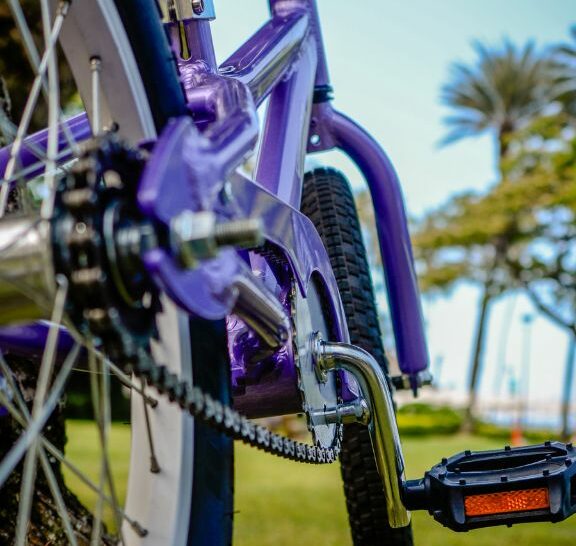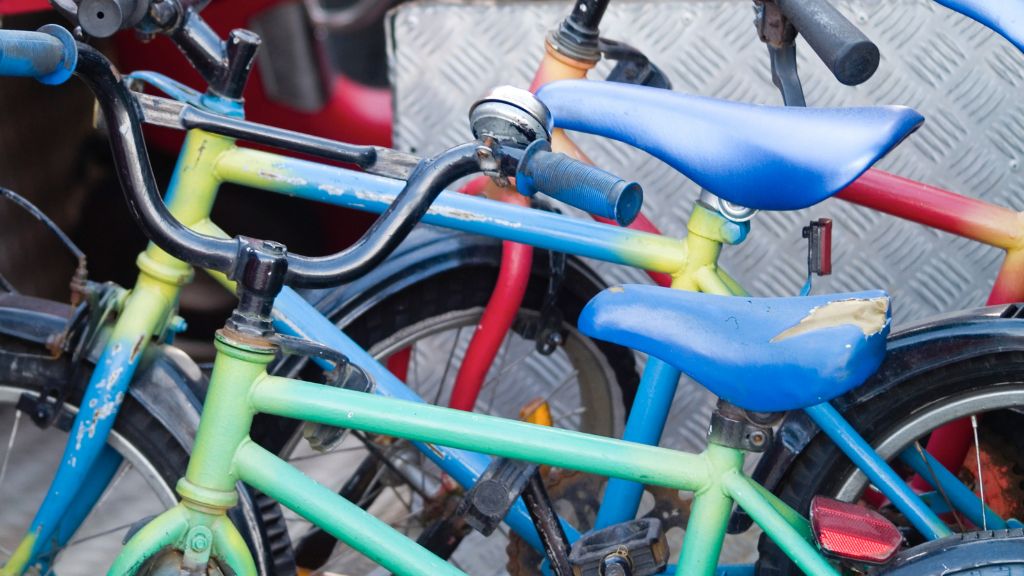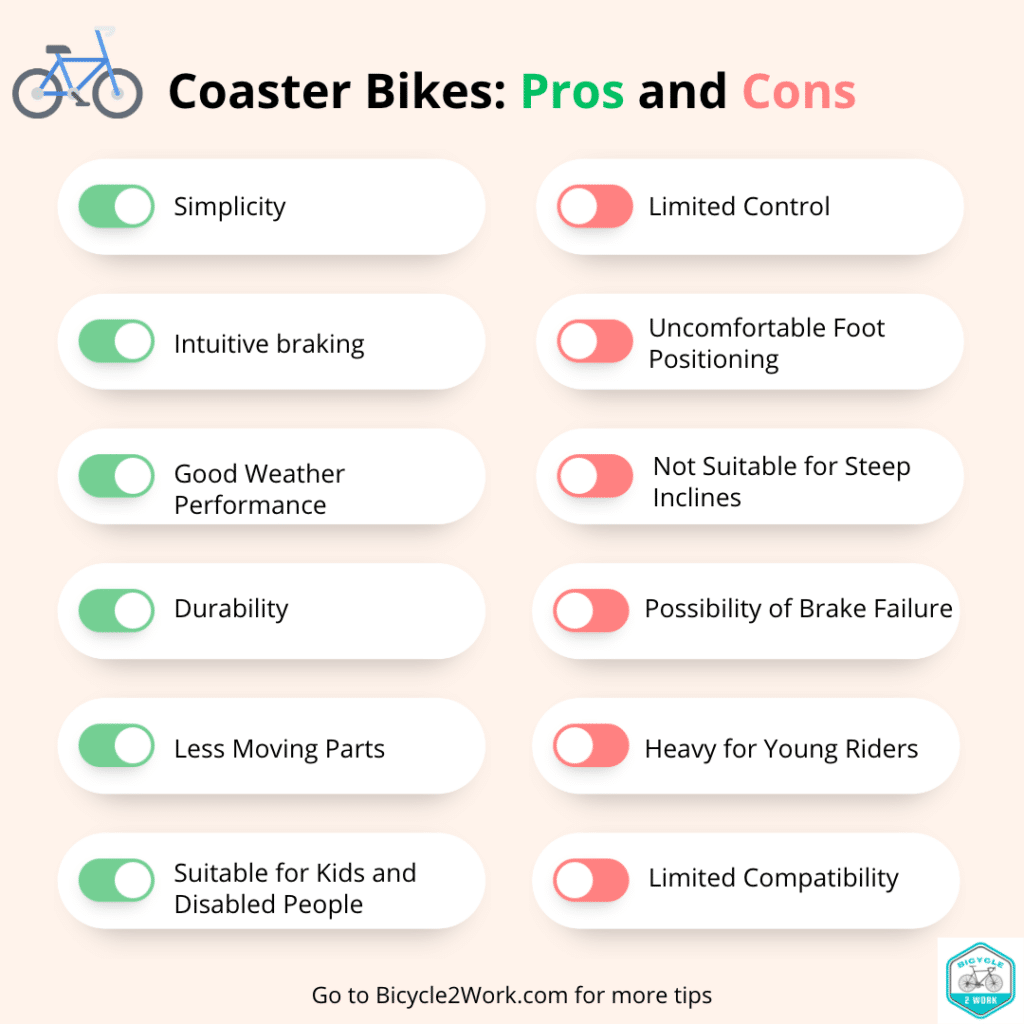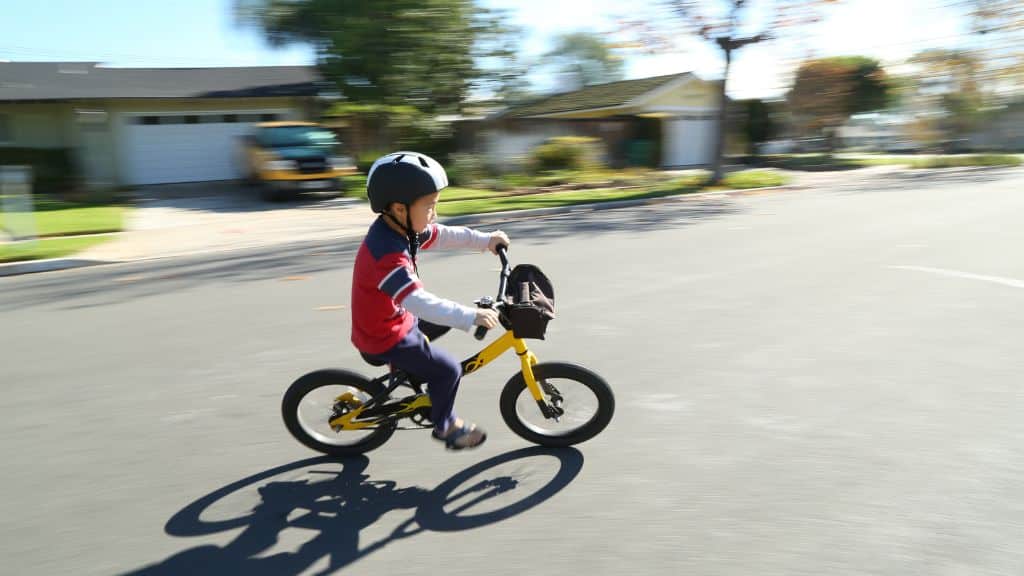This post may contain affiliate links. If you click an affiliate link and make a purchase, I may earn a commission. Also, as an Amazon Associate, I earn from qualifying purchases.--
Are you tired of the same old bikes with boring hand brakes? We introduce the coaster bike, the two-wheeled wonder that’s taking the cycling world by storm (or at least, by a gentle breeze).
What is a coaster bike? Well, it’s a type of bicycle that doesn’t have traditional hand brakes. Instead, it uses a clever contraption called a coaster brake, which is tucked away inside the rear hub of the wheel. The result is a sleek and streamlined look that’s free of bulky brake cables and levers.
So if you’re ready to spice up your cycling routine, it’s time to give the coaster bike a spin. Let’s pedal up and find out more about what makes these bikes a popular choice for the little ones!

What exactly is a Coaster Bike?
Are you ready to pedal your way into a whole new world of biking? Say hello to the coaster bike – the two-wheeled wonder that’s all about simplicity, style, and some serious backpedaling action. But what exactly is a coaster bike, and how does it work?
At its core, a coaster bike is a type of bicycle that uses a special braking system that’s activated by pedaling backward. That’s right; no more fumbling around with confusing hand brakes or worrying about brake cables getting tangled up.
With a coaster bike, all you need to do is give those pedals a swift backward motion, and you’ll be coming to a smooth and satisfying stop in no time.
They’re often found on kids’ bikes and cruiser bikes, as they make it easy to go backward and offer a fun and playful riding experience. Coaster bikes are also single-speed which makes them a perfect learning medium for young riders. If you need help with adapting to single-speed gears, here is a guide to low gears on a bike that will help you along the way!
How do Coaster Bikes work?
The coaster brake is located inside the rear wheel hub and is activated by pedaling backward. The mechanism engages when you start pedaling backward, causing the brake shoes to clamp down on the inside of the hub and slow down the bike. Friction is created between the moving and unmoving elements of the wheel by pressing a brake shoe against the hub of a coaster.
The harder you pedal backward, the stronger the braking will be. And if you keep pedaling backward, the brake will eventually bring the bike to a complete stop.
Coaster Bikes — Pros and Cons
Pros
● Simplicity
Coaster bikes are incredibly simple, with fewer parts than bikes with hand-activated brakes. This simplicity means they require less maintenance and can be more affordable. With fewer components to worry about, fewer things can go wrong, which means that coaster bikes may require less maintenance than bikes with more complex braking systems.
● Intuitive braking
For some riders, especially children, coaster brakes are easier to understand than hand-activated brakes. Pedaling backward to slow down or stop is an intuitive motion that can be easier to learn.
With coaster brakes, you don’t have to worry about coordinating hand movements or pulling levers to slow down or stop. Instead, all you need to do is pedal backward, making it an intuitive and straightforward process that’s easy to learn.
● Good Weather Performance
When it comes to riding in wet conditions, coaster bikes have an advantage over hand-brake bikes. Since the coaster brake is located within the rear hub, it’s less susceptible to water damage. This means that your little ones can enjoy riding in the rain without worrying about the brake bailing on them.
Plus, for those adventurous kids who can’t wait to hit the pavement after a storm, they can rest easy knowing that their coaster brake will provide reliable stopping power.
● Durability
Coaster brakes tend to be more durable than hand-activated brakes. Since the braking mechanism is contained within the hub of the wheel, it is less exposed to the elements and less likely to become damaged. This makes coaster brakes more resistant to wear and tear and more reliable in wet or muddy conditions.
● Less Moving Parts
Let’s face it, bike cables can be a bit of a nightmare. They get snagged on things, they can rust, and they’re just plain unsightly. That’s why coaster brakes are such a refreshing change of pace.
With a coaster brake, there are no cables to worry about. The brake is built right into the hub of the rear wheel, which means you get all the stopping power you need without all the fuss.
● Suitable for Kids and Disabled People
For young riders who are still growing, coaster brakes are an especially good choice. They don’t require the same level of hand strength as traditional hand brakes, which means even the littlest of riders can get in on the action. Since the coaster brake is activated by pedaling backward, it’s a natural movement that most kids find easy to master.
But coaster brakes aren’t just for kids. They’re also a great option for riders of any age who have arm or hand disabilities, amputees, or other mobility issues. With a foot brake, you don’t need to worry about squeezing a lever or applying pressure to a hand grip. You can simply use your foot to apply pressure to the pedal, and the coaster brake will do the rest!

Cons
● Limited Control
Coaster brakes offer limited control over speed, as the rider can only brake by pedaling backward. This can make it difficult to modulate speed and maintain a consistent pace. For riders who require more precise control over their speed, coaster brakes may not offer enough flexibility.
● Uncomfortable Foot Positioning
When it comes to riding a traditional bike with hand brakes, finding the right foot position is key to maximizing your power and control. By placing your feet in the “launch” position on the pedals, you can get the leverage you need for both pedaling and braking.
But with a coaster brake, you need to anticipate stopping ahead of time and position your feet accordingly, since you can’t pedal backward to achieve the launch position.
It might be easy for you to grasp it as an adult but the kids will require time to get the hang of it. It’s like trying to pat your head and rub your belly at the same time – it takes a bit of coordination!😝
● Not Suitable for Steep Inclines
While coaster brakes may be reliable in certain situations, they can pose a challenge for you if you frequently ride in hilly areas or need more precise control over their speed. When riding uphill, riders may need to pedal backward (that requires more effort and energy) to slow down or stop, which can be tiring and may not be sufficient to control speed on steeper inclines.

● Possibility of Brake Failure
A common problem with coaster brakes is that they stop working if the chain breaks off or gets trapped. Coaster brake hubs require the rider to be able to pedal backward while there is a strain on the chain to activate the brake. Inside the hub is a braking mechanism that needs to be tensioned by the chain to function.
After the chain snaps, all braking power is immediately lost. Your kid can only stop the bike by dragging his or her feet on the ground, which is a dangerous and ineffective method.
● Heavy for Young Riders
One of the main issues with coaster bikes is their weight – coaster brakes can add a considerable amount of weight to a child’s bike, making it harder to ride and maneuver. And let’s be real, kids don’t need any extra weight to lug around when they’re already pedaling with all their might!
● Limited Compatibility
Coaster brakes are typically only found on single-speed bikes, which may not be suitable for riders who require multiple gears to navigate varying terrain. For riders who need to cover more varied terrain, a bike with multiple gears may be more appropriate.
Here’s a summary of the pros and cons to share with your cycling friends:

Tips for Riding a Coaster Bike
● Take It Slow
Coaster brakes are a popular choice for their simplicity and low maintenance, but they do require a different approach to riding. This means slowing down well in advance of any turns or obstacles and being mindful of the terrain you’re riding on.
It’s also important to practice using the coaster brake in a safe and controlled environment before taking on more challenging rides.
● Keep Your Weight Centered Over the Pedals
Riding a coaster bike is a unique experience that requires a bit of a learning curve. To ride a coaster bike like a pro, you need to keep your weight centered over the pedals to maintain balance and control.
Balancing is key! Lowering your seat will keep you closer to the ground, allowing you to quickly put your feet down for added stability and balance as you learn the coaster brake technique.

● Coaster Brakes ≠ Hand Brakes
Avoid steep hills and keep your speeds low, especially when you’re first starting out. Coaster brakes simply don’t provide the same stopping power as hand-activated brakes, such as disc brakes or calipers on the wheel rim. So, pushing your coaster bike the same way you did with hand brakes is not a good idea. You won’t be able to stop as quickly, especially on larger downhill rides.
Avoid trying to ride a coaster brake like you would a bike with hand brakes and give yourself time to get used to the new braking system. (Source)
● Practice Pedaling Backward
Coaster bikes require you to pedal backward to engage the brake. This can take some getting used to, especially if you’re used to handling brakes. Practice pedaling backward on flat terrain until it becomes second nature.
● Use Your Body To Slow Down
In addition to using the coaster brake, you can also use your body to slow down. Simply stand up on the pedals and lean back slightly to increase resistance and slow down. Always anticipate stops ahead of time and position your feet on the pedals in the 2 and 4 o’clock and 8 and 10 o’clock positions for optimal leverage when braking.
Coaster Brakes Vs. Hand Brakes – Which is Right for You?
If you are looking for the right braking system for your bike, coaster brakes and hand brakes are two popular options to choose from. Coaster brakes are loved for their simplicity and low maintenance, while hand brakes offer precise control and stopping power.
But what else sets them apart? With the help of this comparison, you will be able to decide whether to stick to backpedaling or finally switch up to hand braking! (Source)
| Coaster Brakes | Hand Brakes |
| Simple and intuitive to use | Can be more complex to operate |
| No external cables or levers | External cables and levers can be adjusted for optimal performance |
| Less maintenance required | Requires more maintenance and adjustment over time |
| May be less effective on steep inclines or technical terrain | Provides greater control and precision on all types of terrain |
| Less prone to wear and tear in wet conditions | Can be affected by wet or muddy conditions |
| May not be suitable for high-speed riding or frequent braking | Provides reliable stopping power in all situations |
I also found this video to be a useful comparison between coaster and hand bikes/brakes:
For kids who are just learning to ride a bike, a coaster brake can be a great option. They can focus on mastering the basics of balance and coordination without having to worry too much about braking. Unlike hand brakes, which require a certain level of coordination and skill to use effectively, a coaster brake simply requires the rider to pedal backward to engage the brake, making it easy for the youngsters to pick up!
Takeaway
Biking isn’t just a way to get from point A to point B; it’s an incredible adventure if done right. And when it comes to adventure, safety should always be a top priority. That’s why choosing the right braking system is so important.
Whether you prefer the simplicity of coaster brakes or the precision of hand brakes, the decision can make a world of difference in your biking experience. Give back-pedaling a chance, you never know if you might like it!
